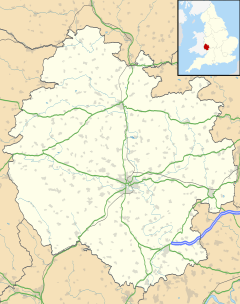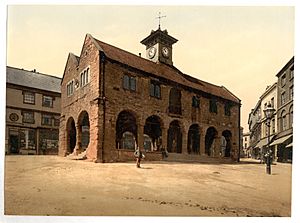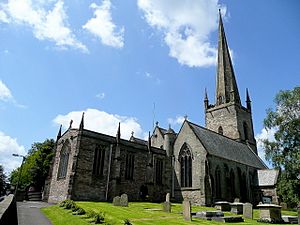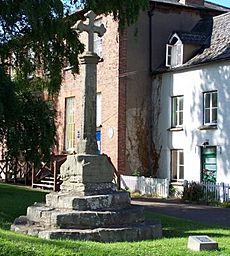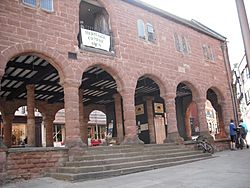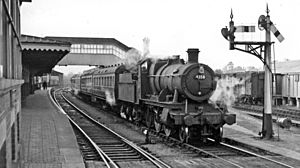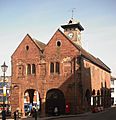Ross-on-Wye facts for kids
Quick facts for kids Ross-on-Wye |
|
|---|---|
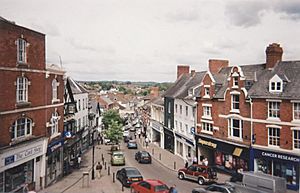 Town centre, looking north from Market House |
|
| Population | 10,700 (2011) |
| OS grid reference | SO597241 |
| Unitary authority | |
| Ceremonial county | |
| Region | |
| Country | England |
| Sovereign state | United Kingdom |
| Post town | ROSS-ON-WYE |
| Postcode district | HR9 |
| Dialling code | 01989 |
| Police | West Mercia |
| Fire | Hereford and Worcester |
| Ambulance | West Midlands |
| EU Parliament | West Midlands |
| UK Parliament |
|
Ross-on-Wye is a busy market town and civil parish in Herefordshire, England. It is close to the border with Wales. In 2021, about 10,978 people lived there. The town is in the south-east of the county, right on the River Wye. It is also on the northern edge of the Forest of Dean.
Contents
History of Ross-on-Wye
The name "Ross" comes from an old Welsh or Celtic word meaning "promontory" (a piece of land sticking out into the sea or a river). In 1931, the town was officially renamed "Ross-on-Wye" by the Post Office. This was to avoid confusion with other places that had similar names, like Ross in Scotland.
Ross-on-Wye proudly calls itself "the birthplace of British tourism". This started in 1745 when a local church leader, Dr John Egerton, began taking his friends on boat trips. They would travel down the River Wye from his home in Ross. People loved the Wye Valley because of its beautiful river views, steep landscapes, and old castles and abbeys. These places were perfect for those looking for "picturesque" (like a beautiful picture) scenery.
In 1782, William Gilpin published his book Observations on the River Wye. This was the first travel guide in Britain that had pictures. After his book came out, more and more people wanted to visit. By 1808, there were eight boats offering trips along the Wye. Most of these boats were rented from inns in Ross and Monmouth. By 1850, over 20 visitors had written about their "Wye Tour". This made the area a very popular place for tourists.
Churches in Ross-on-Wye
The Church of England parish church, St Mary's, is about 700 years old. It is the most famous building in town. Its tall, pointed spire can be seen from far away when you are coming into Ross. Inside the church, there are several special tombs. One tomb belongs to William Rudhall, who died in 1530. His tomb is one of the last big alabaster sculptures made by skilled carvers from Nottingham. Their work was famous all over medieval Europe. Rudhall also helped fix the almshouses (old homes for poor people) near the church in 1575.
Another important tomb is that of John Kyrle. He was a very important person in Ross in the 1700s. The town's secondary school is named after him. You can also find his name at The Man Of Ross, a well-known inn. There is a great painting of him in the Corn Exchange building on High Street.
The Baptist Church in Ross is on Broad Street. In 1731, Baptists built Ryeford Chapel nearby. But in 1817, the people from Ross decided to have their own church. They bought land on Broad Street and built a chapel with a graveyard. The first chapel was replaced in 1879. Much of the money for the new building came from Thomas Blake, a local person who gave a lot to charity. In 2017, the Baptist church in Ross celebrated its 200th birthday.
The Plague Cross
The Plague or Corpse Cross was put up in St Mary's churchyard in 1637. It is a memorial to 315 townspeople who died that year from the plague. They were buried nearby in a plague pit at night, without coffins.
By 1896, the Plague Cross was falling apart, and its top was gone. It was later fixed. Since 1952, it has been a Grade II* listed building, which means it is very important. Since 1997, it has also been a scheduled monument, giving it special protection.
The Prospect Garden
The Prospect is a public garden created by John Kyrle. He rented the land in 1696 and turned it into a beautiful garden and walking path. In 2008, heavy rain washed away some soil and uncovered old Roman remains under the site.
Today, The Prospect is a public garden across from the church. It has trees planted to remember local people, a VE Day Beacon, and a War Memorial. From here, you can see the famous horseshoe bend in the River Wye. On a clear day, you can even see as far west as the Black Mountains.
Ross-on-Wye Today
Ross-on-Wye is famous for its local shops and a market square with a special market hall. Markets are held on Thursdays and Saturdays at the red sandstone Market House building in the town centre. This building was built between 1650 and 1654. It replaced an older building, probably made of wood. The top floor of the Market House is now an arts and crafts centre.
The town has a small theatre called The Phoenix. It shows films once a month and also hosts plays and other arts events.
The old ruins of Wilton Castle, west of the town, have been repaired and are now open for visitors. You can also see several sculptures by Walenty Pytel along the left bank of the River Wye. Many people think both sculptures are swans, but one actually shows ducks!
Getting Around Ross-on-Wye
The old Ross-on-Wye railway station was once an important train stop. It was where the Hereford, Ross & Gloucester Railway met the Ross & Monmouth Railway. The train line opened on June 1, 1855. It later became part of the Great Western Railway in 1862. In 1869, the tracks were changed from a wide "broad gauge" to a narrower "standard gauge" in just five days.
However, because of the Beeching cuts (a plan to close many railway lines in the UK), the train lines to Ross closed in stages until 1964. The old brick station building has been taken down. The area is now an industrial estate, but the old brick goods sheds and engine sheds are still there.
The closest train stations today are in Ledbury (on the Cotswold Line) and Gloucester (on the Birmingham & Gloucester Railway).
Ross-on-Wye is a main stop on Great Britain's road network. The A40 road goes around the north of the town. If you go west, it leads to Monmouth. If you go east, it goes towards Gloucester. The A40 also connects to the northbound A49 to Hereford and the A449 which goes northeast to Ledbury. To the east of Ross is the end of the M50 motorway. This motorway is sometimes called the Ross Spur or Ross Motorway, and it connects to the M5.
You can catch regular bus services from Stagecoach West and Nick Maddy Coaches. Stagecoach West runs an hourly bus (route 33) through Ross between Gloucester and Hereford. Nick Maddy Coaches runs an hourly bus (route 40) that serves the local streets in town. National Express also has a bus service (route 445) that goes to and from London twice a day.
Local News and Media
Local news and TV shows for Ross-on-Wye come from BBC West Midlands and ITV Central. Television signals are received from the Ridge Hill and other local transmitters.
Local radio stations include BBC Hereford and Worcester, Hits Radio Herefordshire & Worcestershire, Greatest Hits Radio Herefordshire & Worcestershire, and Sunshine Radio.
The town has its own local newspapers: The Ross Gazette and the Hereford Times.
Weather in Ross-on-Wye
Ross-on-Wye has a typical British maritime climate. This means it has mild summers and mild winters. A Met Office weather station in Ross has been collecting weather information since 1858. This station has even set some national weather records!
| Climate data for Ross-on-Wye 41m asl, 1991-2020 | |||||||||||||
|---|---|---|---|---|---|---|---|---|---|---|---|---|---|
| Month | Jan | Feb | Mar | Apr | May | Jun | Jul | Aug | Sep | Oct | Nov | Dec | Year |
| Mean daily maximum °C (°F) | 8.0 (46.4) |
8.7 (47.7) |
11.2 (52.2) |
14.2 (57.6) |
17.5 (63.5) |
20.3 (68.5) |
22.3 (72.1) |
21.7 (71.1) |
19.1 (66.4) |
14.8 (58.6) |
10.9 (51.6) |
8.3 (46.9) |
14.8 (58.6) |
| Mean daily minimum °C (°F) | 2.2 (36.0) |
2.2 (36.0) |
3.3 (37.9) |
5.0 (41.0) |
7.8 (46.0) |
10.7 (51.3) |
12.7 (54.9) |
12.5 (54.5) |
10.3 (50.5) |
7.7 (45.9) |
4.6 (40.3) |
2.4 (36.3) |
6.8 (44.2) |
| Average precipitation mm (inches) | 75.9 (2.99) |
55.3 (2.18) |
53.0 (2.09) |
51.9 (2.04) |
56.8 (2.24) |
56.0 (2.20) |
51.4 (2.02) |
64.1 (2.52) |
56.5 (2.22) |
83.7 (3.30) |
79.6 (3.13) |
80.1 (3.15) |
764.3 (30.08) |
| Mean monthly sunshine hours | 54.6 | 77.1 | 119.1 | 166.0 | 203.7 | 200.5 | 210.5 | 189.4 | 143.7 | 103.6 | 63.0 | 47.1 | 1,578.3 |
| Source: Met Office | |||||||||||||
Famous People from Ross-on-Wye
Many interesting people were born in Ross or have lived there. Here are a few:
- John Kyrle (1637–1724), a kind person known as "the Man of Ross"
- James Cowles Prichard (1786–1848), a scientist who studied people and the mind
- Frederick Gordon (1835–1904), a famous hotel owner
- William Partridge (1858–1930), a soldier who was important in the 1879 Zulu war
- Arthur Pugh (1870–1955), President of the Trades Union Congress (a group that helps workers)
- William Henry Squire (1871–1963), a cellist, composer, and music teacher at the Royal Academy of Music
- Frank Andrews (1886–1944), an international rugby union player for Wales and a professional rugby league player
- Frederick Burrows (1887–1973), Governor of Bengal (a region in India)
- Juxon Barton (1891–1980), Governor of Fiji (an island country)
- Noele Gordon (1919–1985), an actress
- Yvonne Littlewood (1927–2023), a television producer
- Dennis Potter (1935–1994), a writer of plays
- Roger Whittaker (1936–2023), a singer and songwriter
- Pete Overend Watts (1947–2017), a member of the band Mott the Hoople
- Dale Griffin (1948–2016), also a member of Mott the Hoople
Sister Cities
Ross-on-Wye has three twin towns (also called sister cities). These are towns in other countries that have a special friendship with Ross:
- Betzdorf, Germany
- Condé-sur-Noireau, France (since 1978)
- Namutumba, Uganda
Images for kids
-
View of the town from the banks of the River Wye
See also
 In Spanish: Ross-on-Wye para niños
In Spanish: Ross-on-Wye para niños


